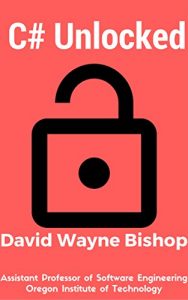This text covers the basic features of C#, and covers what most individuals would learn in a course in C#. To be a useful guide, a text must be more than a dictionary of syntax for a language; it must capture the character and philosophy of the language as well. For example:
•It is useless to talk about threading without discussing race conditions, concurrency, synchronization, deadlock, and all the methods of dealing with these problems.
•Presenting C#’s abilities to access databases isn’t worth much if databases are not well understood by the reader. One of the points of databases is to reduce data redundancy through proper use of primary/foreign keys. A poorly designed database misses the mark entirely, and often makes data access even more inconvenient and error-prone.
•Coverage of network programming must include a discussion of communication protocols as well. Many students don’t understand the difficulties involved with machines communicating with each other, especially when they are different platforms.
Specifically, the text will cover these main areas:
•Simple data types
•Predefined Classes and Structures
•Control Statements
•Object-Oriented Programming (OOP)
•Graphical User Interfaces (GUIs)
•Algorithm Analysis
•Data Structures
•Threads and Concurrency
•Files, Streams, and Database Access
•Network Programming
This text isn’t geared only to the student. Anyone desiring knowledge of C# can understand this book. Only a familiarity with the Windows operating system is necessary, for all development in this text is done in Windows.
The code for this textbook is available at this link:
https://drive.google.com/drive/folders/0ByDBzgq0d2NGVjNxNk9semdqQzA
•It is useless to talk about threading without discussing race conditions, concurrency, synchronization, deadlock, and all the methods of dealing with these problems.
•Presenting C#’s abilities to access databases isn’t worth much if databases are not well understood by the reader. One of the points of databases is to reduce data redundancy through proper use of primary/foreign keys. A poorly designed database misses the mark entirely, and often makes data access even more inconvenient and error-prone.
•Coverage of network programming must include a discussion of communication protocols as well. Many students don’t understand the difficulties involved with machines communicating with each other, especially when they are different platforms.
Specifically, the text will cover these main areas:
•Simple data types
•Predefined Classes and Structures
•Control Statements
•Object-Oriented Programming (OOP)
•Graphical User Interfaces (GUIs)
•Algorithm Analysis
•Data Structures
•Threads and Concurrency
•Files, Streams, and Database Access
•Network Programming
This text isn’t geared only to the student. Anyone desiring knowledge of C# can understand this book. Only a familiarity with the Windows operating system is necessary, for all development in this text is done in Windows.
The code for this textbook is available at this link:
https://drive.google.com/drive/folders/0ByDBzgq0d2NGVjNxNk9semdqQzA



